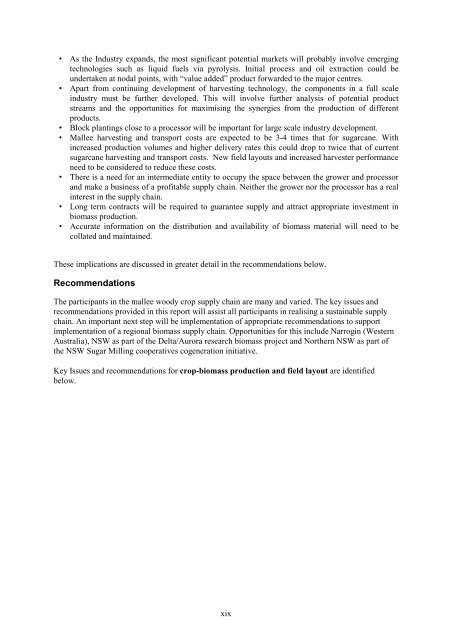Download (4Mb) - USQ ePrints - University of Southern Queensland
Download (4Mb) - USQ ePrints - University of Southern Queensland
Download (4Mb) - USQ ePrints - University of Southern Queensland
You also want an ePaper? Increase the reach of your titles
YUMPU automatically turns print PDFs into web optimized ePapers that Google loves.
• As the Industry expands, the most significant potential markets will probably involve emerging<br />
technologies such as liquid fuels via pyrolysis. Initial process and oil extraction could be<br />
undertaken at nodal points, with “value added” product forwarded to the major centres.<br />
• Apart from continuing development <strong>of</strong> harvesting technology, the components in a full scale<br />
industry must be further developed. This will involve further analysis <strong>of</strong> potential product<br />
streams and the opportunities for maximising the synergies from the production <strong>of</strong> different<br />
products.<br />
• Block plantings close to a processor will be important for large scale industry development.<br />
• Mallee harvesting and transport costs are expected to be 3-4 times that for sugarcane. With<br />
increased production volumes and higher delivery rates this could drop to twice that <strong>of</strong> current<br />
sugarcane harvesting and transport costs. New field layouts and increased harvester performance<br />
need to be considered to reduce these costs.<br />
• There is a need for an intermediate entity to occupy the space between the grower and processor<br />
and make a business <strong>of</strong> a pr<strong>of</strong>itable supply chain. Neither the grower nor the processor has a real<br />
interest in the supply chain.<br />
• Long term contracts will be required to guarantee supply and attract appropriate investment in<br />
biomass production.<br />
• Accurate information on the distribution and availability <strong>of</strong> biomass material will need to be<br />
collated and maintained.<br />
These implications are discussed in greater detail in the recommendations below.<br />
Recommendations<br />
The participants in the mallee woody crop supply chain are many and varied. The key issues and<br />
recommendations provided in this report will assist all participants in realising a sustainable supply<br />
chain. An important next step will be implementation <strong>of</strong> appropriate recommendations to support<br />
implementation <strong>of</strong> a regional biomass supply chain. Opportunities for this include Narrogin (Western<br />
Australia), NSW as part <strong>of</strong> the Delta/Aurora research biomass project and Northern NSW as part <strong>of</strong><br />
the NSW Sugar Milling cooperatives cogeneration initiative.<br />
Key Issues and recommendations for crop-biomass production and field layout are identified<br />
below.<br />
xix
















